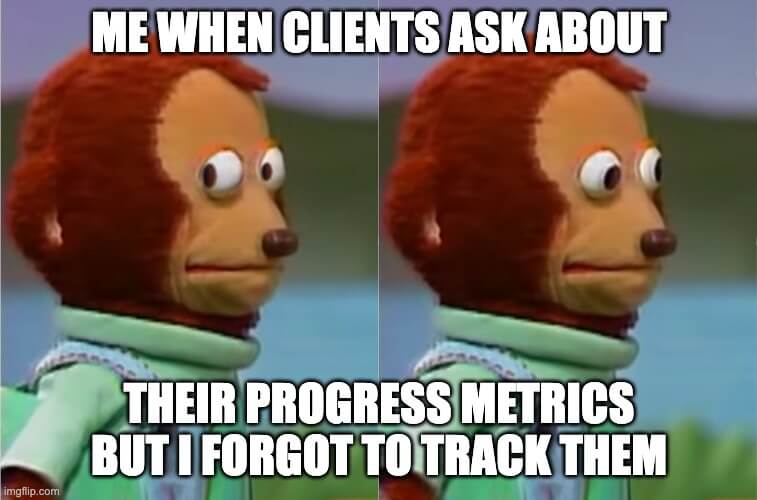So you’ve got a valuable skill and you want to teach others?
Sweet.
But if you think running your own training business is as easy as setting up a Zoom call and saying, “Listen up folks,” think again.

Before you start handing out certificates like Oprah gives out cars, know this…
But being good at what you do (i.e. your skills / expertise) is different from being good at business.
If you want to leverage your skills to build a profitable and enjoyable business, it’s difficult. But it’s worth it.
After reading this blog post, you’ll know the 10 steps (yes TEN steps — that’s why I said it’s hard) to start, build, and run a successful training business.
Step 1: Your Niche and Target Market
The first step is to start with research and strategic planning. Yes — this is a boring topic for most folks, but it’s the foundation. You can’t skip this and expect to build a profitable training business.
A niche is the area of expertise you’ll focus on. The more specific your niche, the better.

Why? Because there are less competition and it’ll be easier for you to stand out. It’s better to be a big fist in a small pond, than a small fish in a big pond… at least in the beginning.
Identifying Your Niche
Here are a few questions to get you started:
What are you good at that others would want to pay you money for?
Can you carve out a small niche based on the niche you’ve just thought about? (E.g. Parenting for teenagers vs Parenting for all ages)
Are there already successful competitors?
Market Analysis
Once you’ve identified your niche, research the target market. This will help you understand the demand for your services and what the competition is offering.
Here’s how to research the market:
1. Analyze Competitors: Look at other businesses offering similar training programs. What are they doing well? What gaps can you fill?
2. Survey Prospective Clients: Use online surveys or interviews to ask them what type of training they need.
3. Industry Trends: Stay up to date with industry trends. For example if you’re offering corporate training find out what skills are in demand by companies today.
Market research will also help you refine your offerings so they match what people are searching for.
Example Niches For a Training Business:
IT skills (coding, cybersecurity)
Soft skills (communication, teamwork)
Fitness and wellness coaching
Creative skills (graphic design, photography)
Marketing and sales strategy
Personal development
Step 2: Create a Business Plan

A business plan is your roadmap for your training business. It should outline your mission, vision, goals, and how you plan to achieve them. Here are some elements to include in your business plan:
Mission Statement: What is the purpose of your business? What value do you offer?
Vision Statement: Where do you see your business in 5 years? 10 years?
Objectives: What are your goals for growth? (How many clients do you want to have? What’s your revenue goal?)
Services: What training course will you offer?
Marketing: How will you attract clients? (We’ll get into this later.)
Financials: What are your expenses (software, marketing, etc.) and projected income?
Timeline: When do you want to launch and at what phase?
Step 3: Work Out Your Pricing
Pricing your training services can be tricky. Make sure you charge enough for it to be valuable worth your time and effort… but also not too much that it doesn’t make sense for potential clients.
Here are some things to consider when working out your pricing:
Cost of Production: How much does it cost to produce and deliver each training program? This includes software subscriptions, equipment costs (if you’re offering in-person sessions) and marketing expenses.
Market Rate: Research what others are charging for similar services.
Perceived Value: Clients will pay more if they believe the value they’re getting is high. For example corporate clients will pay premium prices for leadership development programs that deliver measurable results.
You can also try different pricing models:
Hourly Rate: Charge clients based on the number of hours of training they receive.
Per Course: Set a fixed pricing structure for each course or program.
Subscription Model: Offer ongoing access to courses through a monthly or yearly subscription.
Step 4: Create Great Training Materials For Your Online Training Business
The saying “content is king” is partially true. I say partially because content or information alone isn’t useful. The info has to be applied for it to be useful.
And for the info / training to be applied, your training resources need to be relevant and engaging to your target audience.
Here’s how to create great resources:
1/ Know what your audience needs
Make sure to cover how to solve their pain points and problems.
2/ Use different formats
Different people learn differently. Use different formats like text, videos, and live trainings.
3/ Implementation beats theory
Use real-life examples and case studies. Also create quizzes or projects to get students to apply what they learn.
4/ Keep up-to-date
Industries move fast. Make sure your content and approach stays current with what’s working now.
Step 5: Build Your Training Business Infrastructure
An Online Presence
The next step on how to start a training business is to have an online presence.
In this day and age, if your business doesn’t have an online presence, be prepared to close up shop.
Even if you don’t run a physical e-com business, you still need to “be online”. Because people are going to search for your brand and reputation online regardless of the type of business you run.
1/ Create a Website
Sure, social handles on the various social platforms are great.
But having an actual website that you call home — one that has your brand as the domain — builds more credibility than if you don’t have one.
Consider adding a blog to your website so you can create helpful content for your target audience. Done correctly, you’ll get visitors from the search engines.
2 /Social Media Channels
Choose the social media platforms where your target audience is active (e.g. LinkedIn for corporate clients). Use these platforms not just for promotion but also to engage with followers by sharing useful content or answering questions related to their needs.
3/ Email Marketing
Build an email list by offering free resources like eBooks or webinars in exchange for email addresses — then use this list when you launch new courses. Email marketing tools like BirdSend is a good fit as it’s especially built for course creators and coaches.
Get a User-Friendly Learning Management System (LMS) for Your Online Courses
If you’re going to offer online training you need to invest in a Learning Management System (LMS). A LMS is a platform that allows you to create, deliver and manage your training programs. It also provides a seamless experience for your learners to access course materials, track their progress and complete assessments.
Here’s what to look for when choosing an LMS:
Ease of Use: Both you and your learners should find the platform easy to use. Look for an LMS with a clean design and simple features.
Customization: Can you brand the platform with your logo and colors? Customization helps to build your brand.
Scalability: As your training business grows you’ll want an LMS that can handle more learners and more courses without performance issues.
Analytics: A good LMS should provide data on learner progress, course completion rates and engagement levels. This helps you to improve your courses over time.
Integration: Make sure the LMS integrates with other tools you use, like email marketing platforms or payment gateways.
Popular LMS options are platforms like Teachable, Thinkific and Kajabi. These platforms are for entrepreneurs and small business owners who want to offer online courses.
Step 6: Set Up a Physical or Virtual Training Center

Depending on your business model you may want to offer in-person training sessions in addition to or instead of online courses. If so you’ll need to set up a physical or virtual training center.
– Physical Training Center: If you’re offering in-person training you’ll need a dedicated space for clients to attend sessions. This could be anything from renting a small office space to partnering with local co-working spaces or community centers.
Make sure the space is comfortable and has the necessary tools (e.g. projectors, whiteboards).
Consider accessibility—make sure it’s easy for clients to get to your location.
– Virtual Training Center: If you’re doing online training your “training center” will be virtual. This means creating an environment where learners can interact with you and each other.
Use video conferencing tools like Zoom or Microsoft Teams for live sessions.
Create discussion forums or chat groups where learners can ask questions and network with each other.
Whether physical or virtual the key is to create an engaging and supportive learning environment that encourages participation.
Step 7: Track Success

To make sure your training business is on track you need to develop systems to track learner success and business performance. This will help you to identify areas to improve and make informed decisions as you grow. You’ll also be able to see market trends.
Here’s how to track success:
1. Client Feedback: Ask clients for feedback on their experience with your training programs. Use surveys or interviews to find out what they liked and what could be improved.
2. Course Completion Rates: Monitor how many people complete your courses. Low completion rates means the content is too hard or not engaging enough.
3. Learner Outcomes: Measure if learners are achieving the goals they set out to achieve by taking your course (e.g. gain new skills, advance in their career).
4. Business Metrics: Track key performance indicators (KPIs) like revenue growth, customer acquisition costs and client retention rates.
By monitoring these metrics you’ll be able to tweak your offerings and make sure both your clients and business are thriving.
Step 8: Launch and Market Your Training Business
Now that you have the foundation of your training business—created great content, set up an LMS or physical space and developed tracking systems—it’s time to launch! But launching isn’t just about going live; it’s also about getting the word out.
Launch With a Marketing Plan
A marketing plan is key to getting clients when you first launch. Here are some ways to market your new training business:
1. Social Media: Social media platforms like LinkedIn, Facebook, Instagram and Twitter are powerful marketing tools.
Share content related to your niche (e.g. tips, industry news) to build credibility.
Engage with potential clients by responding to comments or participating in relevant groups/discussions.
2. Content Marketing: Create blog posts or videos that address common pain points in your industry. For example if you’re offering leadership training for managers write articles about “How New Managers Can Lead Effectively”. This positions you as an expert and also improves SEO (Search Engine Optimization) so people can find you through search engines like Google.
3. Email Marketing: Build your own “asset” in the form of an email list of folks who’re interested in what you do. Contrary to social media, you own this list. It’s yours forever. Nobody can take it away from you.
Once people are on your list nurture them by sending valuable content and then pitch paid courses.
4. SEO (Search Engine Optimization): Optimize your website so it ranks higher on search engines when people are looking for services like yours.
Use keywords throughout your website content (e.g. “corporate training”, “leadership development”).
Make sure your website loads fast on mobile devices as many people will be accessing your site via their smartphones.
5. Paid Advertising: If you have budget consider using paid ads on platforms like Google Ads or Facebook Ads. Paid ads can get you immediate visibility while organic marketing takes time.
Offer Free Resources or Introductory Workshops
One of the best ways to get new clients is to offer free resources or introductory workshops. These give potential clients a taste of what you have to offer without them having to commit financially upfront.
– Free Resources: Create downloadable guides or templates that solve common problems in your niche (e.g. “A Beginner’s Guide To Public Speaking”). Offer these resources on social media or through email sign ups.
– Introductory Workshops/Webinars: Host free workshops where participants get to experience some of the concepts covered in paid courses. For example:
If you’re offering online fitness coaching—host a free workout session!
If you’re providing corporate communication skills—run a free webinar on email writing!
These free offerings build trust between you and potential clients and showcase the value they’ll get from paid services.
Network with Industry Professionals
Networking is a big part of any business and it’s no different when starting a training company! By building relationships with other professionals within (or adjacent) industries who have similar audiences—you open up opportunities for collaboration which could lead to new client acquisition!
Here are some networking strategies:
Attend industry conferences/events where prospects will be.
Join professional associations related to specific sectors you’re targeting (i.e. HR associations if you’re focusing on corporate employee development).
Collaborate with complementary service providers—other consultants who specialise in different but related fields!
Networking will increase visibility and credibility towards the services you offer!
Step 9: Sales Strategy for Your Training Business

Once you’ve launched your training business and started marketing it you need to develop a sales strategy to convert leads into paying clients. A well thought out sales approach will help you maximize your revenue and keep your business profitable.
Here’s how to create a sales strategy:
1/ Define Your Sales Funnel
A sales funnel is the journey that potential clients take from first discovering your business to becoming paying clients. Here are the stages of a typical sales funnel:
Awareness: This is where they first hear about your business, often through marketing like social media, blog posts or ads.
Interest: At this stage they are interested in what you offer and may sign up for a free resource or attend an introductory workshop.
Consideration: Now they’re deciding whether to buy one of your paid courses or services.
Conversion: Finally they buy.
By understanding each stage of the funnel you can tailor your marketing and sales efforts to guide prospective clients to buy.
2/ Discounts or Promotions
People love a good deal! Offer limited time discounts or promotions to encourage hesitant prospects to buy.
For example offer 10% off for first time clients or bundle multiple courses together at a discounted price.
You could also run seasonal promotions (e.g. back-to-school discounts) or offer early bird pricing for new courses.
3/ Customer Support
Great customer service can make all the difference in converting leads into paying clients—and keeping them coming back for more.
Make it easy for potential clients to get in touch with you about your courses or services.
Respond quickly to inquiries and be as helpful as possible. This builds trust and shows you care about their success.
4/ Testimonials and Case Studies
Social proof is a powerful way to convince potential clients that your training programs are worth investing in. Share testimonials on your website and social media.
If possible create case studies that show how your training helped previous clients achieve specific results (e.g. “After completing our leadership development program Client X increased team productivity by 20%”).
5/ Upsell and Cross-Sell
Once someone has bought one of your courses you can offer them other products or services.
Upselling is when you encourage customers to buy a more expensive version of what they’ve already bought (e.g. one-on-one coaching sessions in addition to group training).
Cross-selling is when you recommend related products or services (e.g. if someone buys a time management course suggest they also buy a productivity course).
Step 10: Growing and Expanding Your Training Business

Once your training business is up and running don’t get complacent. Continuous growth and improvement is key to long term success. Here’s how you can scale your business while keeping your training programs effective.
Continuously Review and Refine Your Training Programs
To stay ahead in the ever changing training industry you need to regularly review and improve your training programs. So they stay relevant, engaging and valuable to your learners.
Here’s how to review your offerings:
1. Get Feedback from Clients: After each training session or course ask participants for feedback on their experience. What did they find most useful? What could be improved? Use this to make changes where needed.
2. Keep up to date with Industry Trends: Learner needs change over time as industries evolve. Stay informed about the latest trends in your niche so you can update your content accordingly.
3. Monitor Learner Outcomes: Track how well participants are applying what they’ve learned in real life. Are they seeing results? If not consider revising certain parts of the curriculum.
Add to Your Training Services
As your business grows you may want to add to your services to reach a wider audience or meet new demands in your niche.
Here are some ways you can add:
Corporate Training Programs: Many companies invest heavily in employee development so corporate training is a big market. Consider creating programs for businesses looking to upskill their workforce.
Certification Programs: Offering certification on completion of certain courses adds value for learners who want to be able to put it on their resume or LinkedIn profile.
New Courses: As you gain more experience and listen to direct feedback from your students / customers, add relevant courses that complement your existing ones. Over time, your portfolio of courses will get more complete and you’ll be able to attract more customers.
Constant Upskilling
To stay effective and deliver great training, you need to develop yourself as a trainer.
Here’s how:
Attend in person workshops or virtual ones on training delivery or adult learning principles.
Take online courses in your topic areaᅳthis will give you a sense of whazt makes a good online learning experience.
Join a professional association to network with other trainers and stay up-to-date on best practices.
Offer On-the-Job Training
On-the-job training is a great way to enhance your services and offer even more value to clientsᅳespecially in the corporate market.
Here’s why it’s a good idea:
Employees learn by doing and gain practical experience while developing skills directly applicable to their job.
Companies love it when employees have hands-on training that improves performance immediately.
If this is relevant to your niche (like leadership development), consider creating customized on-the-job training initiatives for clients.
TL;DR
Now you know how to start a training business. It’s definitely not easy, but well worth it.
You’ll need to plan, market, evaluate, and improve — and you absolutely must have a passion for teaching others!
If you follow the steps above — identifying your niche, doing your homework, developing great resources, getting online, launching a marketing effort, networking effectively, reviewing your programs, and adding services — you’ll be well on your way to creating a profitable business that offers real value to clients.
And don’t be afraid to be flexible 🙂
Related
- SendOwl vs Gumroad: The Recurring Revenue Black Hole (2026)
- Gumroad vs Sellfy: The Vendor Lock-in Cage (2025)
- Gumroad vs Payhip: The Hidden Trap for Creators (2025)
- ThriveCart vs SamCart – The Subscription Hostage Trap (2025)
- 8 ThriveCart Alternatives & The Lifetime Pricing Paradox (2025)
- 8 SamCart alternatives + Subscription hostage (2025)
- The GENTLE Method: Soft marketing for creators
- How Far in Advance Should You Promote a Webinar?
- The SAVINGS Method: The Productivity Improvement Plan for Creators
- 9 Questions to Ask: How to Hire a Digital Marketing Agency
